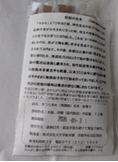Katsura Ame
Katsura Ame from Yoro-tei, founded 360 years ago, has been revived after 12 years since it closed!
A golden-colored candy like honey made by boiling down the sap of sweet vine, a member of the grape family called amazura.
Yoshie Doi
 A signboard handed down from the Edo period |
 |
 Katsurame’s costume |
 Katsura Ame will be revived as a return gift from the Katsura Rokusai Nenbutsu Preservation Society on May 5, 2025 |
 |
 Pine bark diamond pattern |
Katsurame were women who sold sweetfish caught in the Katsura River and Katsura candy, and lived in Katsura from the Heian period to the Edo period. According to Toyama Takao, also known as the 12th Ameya Rihei, there were 10 Ameya shops in Kamikatsura and 3 in Shimokatsura during the Edo period, but they were hereditary and have now disappeared, and can only be remembered at the Jidai Matsuri festival. Katsurame’s crest, the pine bark diamond, is depicted on their costumes and on the bags of Katsura candy.
Katsura already appears in the Nihon Shoki (720) as “Katsura no”. The “Katsura Tsutsumi”, a white cloth that covers the head, which is a characteristic of “Katsurame”, is said to have its roots in the belly band that was given to Princess Katsura, who is said to be the ancestor of “Katsurame”, by Empress Jingu. Why a belly band? After the sudden death of her husband Emperor Chuai, she invaded Silla while pregnant, and it is said that she wore the belly band to keep her stomach cool in order to delay the birth of the future Emperor Ojin.
Legend has it that “Katsurahime” was the daughter of Takeuchi no Sukune, and that the recipe for candy passed down by “Katsurahime” later became “Katsura Ame”. It is also said that the origin of the candy came from the women of a group of cormorant fishermen who presented sweetfish caught in the Katsura River to the Imperial Court in the late Heian period.
The book on the history of Katsura Ame states that it was the “former Katsura Imperial Palace candy store,” and it has a history of donating candy to the Katsura Imperial Villa and the Imperial Family. According to the 12th generation owner of Katsura Ame, Ameya Rihei, also known as Toyama Takao, every time the store was succeeded by a new head of the family, they would submit a written statement to the magistrate that they were the official candy store for the Katsura Imperial Palace, and they would hang a sign bearing the Imperial Chrysanthemum crest at the entrance to the store.
The oldest record of eating ice in Japan in the summer is found in The Pillow Book. In the section on “Delicious Food,” there is a passage that reads, “Sweet redcurrants are placed in shaved ice and placed in a new metal bowl.” As time went on, sweets chilled in icehouses became popular, and the shape of the confectionery changed to become today’s Kyoto specialty, “minatsuki.” Translated in modern terms, this means “something elegant…finely shaved ice topped with sweet sauce and served in a new gold bowl.” There is also a place called Himuro in Kyoto, where ice to be presented to the emperor in midsummer was stored from midwinter.
During the Heian period, there was no sugar as we know it today, and instead, shaved ice was made by boiling down the sap of amazura, a vine plant in the grape family, into a golden syrup similar to honey. This is the raw material for katsura candy. When Emperor Ojin was a child, he drank amazura candy dissolved in hot water instead of milk. As sugar became more widespread, amazura was gradually forgotten, and has become a mythical sweetener today. Ice was a valuable commodity at the time, and only the nobility could eat shaved ice.
The end of document
Translated by Masami Otani
